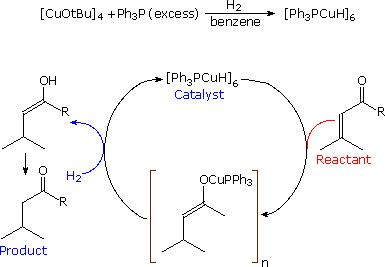Formula C108H96Cu6P6 | ||
 | ||
Stryker's reagent ([(PPh3)CuH]6), also known as the Osborn complex, is a hexameric copper hydride ligated with triphenylphosphine. It is a brick red, air-sensitive solid. Stryker's reagent is a mild source of hydride and is used in homogeneous catalysis of conjugate reduction reactions of enones, enoates, and related substrates.
Contents
- Preparation and structure
- Applications in organic synthesis
- Modifications to Strykers reagent
- References

Preparation and structure

The compound is prepared by hydrogenation of copper(I) tert-butoxide, generated in situ from copper(I) chloride and sodium tert-butoxide. Other more convenient methods have been developed since its discovery.

In terms of its structure, the compound is an octahedral cluster featuring Cu(PPh3) centres that are bonded by weak Cu---Cu interactions. Originally six of the eight faces were thought to be capped by hydride ligands. The structural assignment has been revised the hydrides are best described as edge bridging rather than face bridging.
Applications in organic synthesis

The compound can effect highly regioselective conjugate reductions of various carbonyl derivatives including unsaturated aldehydes, ketones, and esters. This reagent was assigned as the "Reagent of the year" in 1991 for its functional group tolerance, high overall efficiency, and mild reaction conditions in the reduction reactions. Stryker's reagent is used in a catalytic amount where it is regenerated in the reaction in situ using a stoichiometric hydride source, often being molecular hydrogen or silanes. If stored under an inert atmosphere (e.g. argon, nitrogen) it has indefinite shelf life. Brief exposure to the oxygen does not destroy its activity significantly, although solvents used with Stryker's reagent should be rigorously degassed.
Modifications to Stryker's reagent
Ligand-modified versions of Stryker's reagent have been reported. By changing the ligand to e.g. P(O-iPr)3 the selectivity can be improved significantly.
